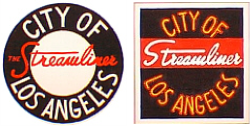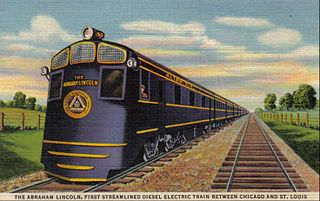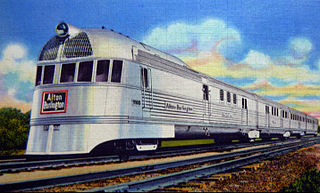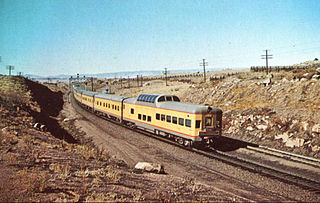
The Broadway Limited was a passenger train operated by the Pennsylvania Railroad (PRR) between New York City and Chicago. It operated from 1912 to 1995. It was the Pennsylvania's premier train, competing directly with the New York Central Railroad's 20th Century Limited. The Broadway Limited continued operating after the formation of Penn Central (PC) in February 1968, one of the few long-distance trains to do so. PC conveyed the train to Amtrak in 1971, who operated it until 1995. The train's name referred not to Broadway in Manhattan, but rather to the "broad way" of PRR's four-track right-of-way along the majority of its route.

The City of Denver was a streamlined passenger train operated by the Union Pacific Railroad between Chicago, Illinois, and Denver, Colorado. It operated between 1936 and 1971. From 1936–1955 the Chicago and North Western Railway handled the train east of Omaha, Nebraska; the Chicago, Milwaukee, St. Paul and Pacific Railroad handled it thereafter. The train was the fastest long-distance train in the United States when it debuted in 1936, covering 1,048 miles (1,687 km) in 16 hours. For almost its entire career its principal competitor was the Chicago, Burlington and Quincy Railroad's Denver Zephyr. When Amtrak assumed operation of most intercity trains in the United States in 1971, it discontinued the City of Denver, preferring to use the Burlington's route between Chicago and Denver.

The City of Los Angeles was a streamlined passenger train between Chicago, Illinois, and Los Angeles, California via Omaha, Nebraska, and Ogden, Utah. Between Omaha and Los Angeles it ran on the Union Pacific Railroad; east of Omaha it ran on the Chicago and North Western Railway until October 1955 and on the Milwaukee Road thereafter. The train had number 103 westbound and number 104 eastbound.

A dome car is a type of railway passenger car that has a glass dome on the top of the car where passengers can ride and see in all directions around the train. It also can include features of a coach, lounge car, dining car, sleeping car or observation. Beginning in 1945, dome cars were primarily used in the United States and Canada, though a small number were constructed in Europe for Trans Europ Express service.

The Nebraska Zephyr was a streamlined passenger train operated by the Chicago, Burlington and Quincy Railroad between Chicago, Illinois; Omaha, Nebraska; and Lincoln, Nebraska, from 1947 to 1971. Until 1968, the service was provided by two Twin Cities Zephyr articulated trainsets — the "Train of the Gods" and "Train of the Goddesses" — that became synonymous with it. The Nebraska Zephyr was one of many trains discontinued when Amtrak began operations in 1971. The "Train of the Goddesses" set is preserved at the Illinois Railway Museum in Union, Illinois.

The Southern Belle was a named passenger train service offered by Kansas City Southern Railway (KCS) from the 1940s through the 1960s, running between Kansas City, Missouri, and New Orleans, Louisiana.

The Golden State was a named passenger train between Chicago and Los Angeles from 1902–1968 on the Chicago, Rock Island and Pacific Railroad and the Southern Pacific Company (SP) and predecessors. It was named for California, the “Golden State”.

The City of St. Louis was a streamlined passenger train operated by the Union Pacific Railroad and the Wabash Railroad between St. Louis, Missouri, and Los Angeles, California. It operated from 1946 to 1971.

The National Limited was the premier train of the Baltimore and Ohio Railroad (B&O) on its route between Jersey City, New Jersey, and St. Louis, Missouri, with major station stops in Washington, D.C., and Cincinnati, Ohio. It operated from 1925 to 1971. For much of its life it offered exclusive all-Pullman service, and it was the first long-distance train to be entirely air-conditioned. The National Limited was one of many trains discontinued when Amtrak began operations on May 1, 1971. Amtrak revived the name for another New York–St. Louis service which did not use the B&O route.

The Rocky Mountain Rocket was a streamlined passenger train of the Chicago, Rock Island and Pacific Railroad. Rock Island's train numbers 7 and 8 ran between Chicago's LaSalle Street Station and Denver's Union Station and Colorado Springs, Colorado. The Rocky Mountain Rocket ran from 1939 to 1966; the train was discontinued prior to the creation of Amtrak in 1971.

The Abraham Lincoln was a named passenger train operated by the Baltimore and Ohio Railroad from 1935 into the 1960s. The Abe Lincoln ran between Chicago and St. Louis on the B&O's subsidiary Alton Railroad. The train later passed to the Gulf, Mobile and Ohio Railroad, and then finally to Amtrak, which retained the name until 1978. Service between Chicago and St. Louis is now known by the umbrella term Lincoln Service. This train was the first streamlined passenger service to travel the 284 miles between Chicago and St. Louis, with Joliet, Bloomington-Normal, Springfield and Alton in between. Passengers can get a glimpse of the Mississippi River between Alton and St. Louis.

The City of Memphis was a 236.8-mile (381.1 km) passenger train route operated by the Nashville, Chattanooga and St. Louis Railway connecting Nashville's Nashville Union Station and Memphis, Tennessee's Memphis Union Station.

The Firefly was a streamlined passenger train operated by the St. Louis – San Francisco Railway. At various times, it served St Louis, Missouri, Tulsa and Oklahoma City, Oklahoma, Kansas City, Missouri, and Fort Scott, Kansas. It made its maiden run on March 29, 1940, and ended May 22, 1960. It was Frisco’s first streamliner, and the first streamliner to be built in the southwest.

The Wabash Railroad was a Class I railroad that operated in the mid-central United States. It served a large area, including track in the states of Ohio, Indiana, Illinois, Iowa, Michigan, and Missouri and the province of Ontario. Its primary connections included Chicago, Illinois; Kansas City, Missouri; Detroit, Michigan; Buffalo, New York; St. Louis, Missouri; and Toledo, Ohio.

The Pere Marquette was a streamlined passenger train operated by the Pere Marquette Railway and its successor the Chesapeake and Ohio Railway (C&O) between Detroit and Grand Rapids, Michigan. It operated from 1946 to 1971. It was the first new streamliner to enter service after World War II. Although discontinued in 1971 on the formation of Amtrak, in 1984 Amtrak revived the name for a new train between Chicago, Illinois and Grand Rapids.

The Green Diamond was a streamlined passenger train operated by the Illinois Central Railroad between Chicago, Illinois and St. Louis, Missouri. It operated from 1936 until 1968. It was the Illinois Central's first streamliner. Initially it operated with Illinois Central 121, the last of the 1930s fixed-consist articulated streamliners built in the United States.

The Ozark State Zephyr was a streamlined passenger train operated by the Chicago, Burlington and Quincy Railroad (CB&Q) and the Alton Railroad between St. Louis and Kansas City in Missouri, home of the Ozarks. It operated from 1936 to 1939. The Zephyr was one of several short-haul Midwestern routes operated by the CB&Q's then-revolutionary articulated streamlined trainsets, including one of the original Twin Cities Zephyrs.

The Blue Bird was a streamlined passenger train operated by the Wabash Railroad and its successor the Norfolk and Western Railway between Chicago, Illinois, and St. Louis, Missouri. It operated from 1938 to 1971. Beginning in 1950 it was one of the few Wabash passenger trains to carry a dome car and the first dome train in regular operation between the two cities. The train was cut back to Decatur, Illinois, in 1968 and renamed City of Decatur. Amtrak did not retain the City of Decatur, which made its last run on April 30, 1971.

The Astra Domes were a fleet of streamlined dome cars built by the American Car and Foundry Company ("ACF") and later by Pullman-Standard ("PS") for the Union Pacific Railroad between 1954–1958. ACF built a total of 35 cars including coaches, dining cars, and observation cars, while PS built 5 for Union Pacific. After Union Pacific exited the passenger business in 1971 the Auto-Train Corporation purchased most of the fleet and operated them for an additional ten years.

The Wabash Cannon Ball was a passenger train on the Wabash Railroad that ran from 1950 to 1971. The train was named after the song "Wabash Cannonball". It was the second train to bear the name "Cannon Ball"; the first was the fast express Cannon Ball, which ran in the late 1800s to the early 20th century.





















